In his essay “The Braindead Megaphone,” author George Saunders tells a story about a party in which attendees’ conversations are interrupted by a man who enters carrying, and speaking into, a megaphone. Listeners, the narrator remarks, slowly alter their behavior, depending on what he shouts.
“If he weaves into his arguments the assumption that the west side of the room is preferable to the east, a slow westward drift will begin. These responses are predicated not on his intelligence, his unique experience of the world, his powers of contemplation or his ability with language, but on the volume and omnipresence of his narrating voice. His main characteristic is his dominance. He crowds the other voices out, his rhetoric becomes the central rhetoric because of its unavoidability,” Saunders writes. Holding the megaphone is about holding power over the room.
The Citizen Architect campaign, released by The American Institute of Architects in 2008, provides a platform to launch architects out of their practice and into communities. AIA’s Citizen Architect handbook describes itself as a resource that “offers insight into the important role architects play in advancing public policy and methods that encourage greater civic engagement by architects.” It provides guidance on attending local meetings, meeting with elected representatives, running for elected offices, getting appointed to municipal positions, lobbying congresspeople about pressing issues, and volunteering—all of which require architects to be attuned to the needs and burdens of the communities in which they live.
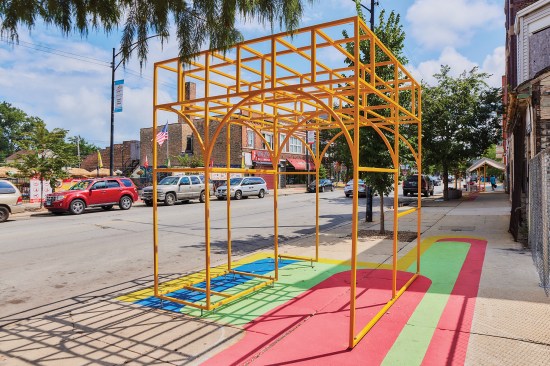
Sarah Joyce
Completed in 2021, Chicago Alfresco: South Chicago is one of three pop-up interventions the city initiated “to increase amenities and social spaces during COVID,” says Design Trust Chicago’s Katherine Darnstadt.
Much of the Citizen Architect campaign is predicated on the importance of “design thinking,” a term that has been popularized by companies like globally based IDEO and is defined by a multistep process for solving complex organizational and social problems. That process, according to author Rebecca Ackermann in her 2023 MIT Technology Review article “Design thinking was supposed to fix the world. Where did it go wrong?,” was rooted in collaboration and empathy. “We are all creatives, design thinking promised, and we can solve any problem if we empathize hard enough,” she writes. But, as she goes on to detail throughout the story, design thinking’s “shine has begun wearing off.”
“Critics have argued that its short-term focus on novel and naive ideas has resulted in unrealistic and ungrounded recommendations. And they have maintained that by centering designers—mainly practitioners of corporate design within agencies—it has reinforced existing inequities rather than challenging them,” Ackermann writes. Design thinking, therefore, is built primarily to focus on designers; architecture, as an industry, has benefited historically from its proximity to power—especially wealth and political clout. Should architects, then, be tasked with further promoting their own skills to meet the needs of diverse communities? Perhaps the Citizen Architect campaign should be structured as a political and social reeducation in which architects see themselves not as uniquely trained to be leaders, but instead as a part of a vital ecosystem of collaboration that redistributes their power, passing the megaphone in order to center communities—those burdened by environmental injustices, histories of segregation and redlining, racialized disinvestment, and systemic poverty—and not design.
Municipalities don’t often create or enforce minimum standards for working with vulnerable neighborhoods. Without this guidance, the Citizen Architect runs the risk of being yet another brain-dead megaphone-wielder, out of touch with the voices they claim to represent.
Unfortunately, AIA, despite having standards for myriad other components of design and practice, lacks guidelines for redistributing power to communities. The Citizen Architect handbook, updated in 2018, provides a list of ways to become a Citizen Architect. Most suggestions are maddeningly short, or refer readers to outside tools like the United Nations Conference on Housing and Sustainable Urban Development on how to hold an outreach event, leaving me to ask: Do you really need to consult the U.N. to talk to your neighbors? But most of those suggestions, again, seem to place architects in positions of leadership and power, not listening.
“Community engagement,” a term that is often used to denote focus groups, meetings, and other activities that capture anything resembling how architects might redistribute their power, remains an opaque, all-encompassing term with little guidance. Municipalities don’t often create or enforce minimum standards for working with vulnerable neighborhoods. Without this guidance, the Citizen Architect runs the risk of being yet another brain-dead megaphone-wielder, out of touch with the voices they claim to represent. These standards are being developed, however, through collaborations between firms, civic groups, and local governments—an ecosystem of shared amplification developed through cooperative citizenship.
Private Practice Can’t Do It Alone
Because design thinking is a process formed of a traditional client-designer relationship, it is naturally oriented toward business-friendly practices. This, Ackermann noted, is counterintuitive to what vulnerable communities need. “Slowing down and embracing complexity are the keys to moving practices like design thinking toward justice,” she writes. Working at the speed that architecture typically operates centers capital, not people, and working effectively with communities takes generosity of time, and thus often generosity of budget.
In 2020, the Oregon Department of Transportation proposed to cover the I-5 freeway near the Lower Albina neighborhood in Portland, creating a small park on the cover. But the neighborhood, a once-thriving Black community that was demolished to make way for the freeway in 1962, wanted something more than a park. So ODOT paused the project and used $5 million to bring on locally headquartered ZGF Architects, led by R. Steven Lewis, FAIA, for a new planning process.
![In Portland, Ore., ZGF Architects worked closely with residents of the Lower Albina neighborhood, a once-thriving Black community that was decimated by the 1962 construction of the I-5 freeway, to dream up design options that would revitalize the area while “facilitat[ing] restorative justice for the Albina community,” according to a ZGF project description.](https://architectmagazine.stg.zonda.onl/wp-content/uploads/sites/5/2025/06/zgf-i-5-rose-quarter-assessment-16b.jpg?w=623)
courtesy ZGF Architects
In Portland, Ore., ZGF Architects worked closely with residents of the Lower Albina neighborhood, a once-thriving Black community that was decimated by the 1962 construction of the I-5 freeway, to dream up design options that would revitalize the area while “facilitat[ing] restorative justice for the Albina community,” according to a ZGF project description.
“Our team worked passionately together through a lot of difficult, knotty problems to bring our best thought processes and empathy to our evaluation,” Lewis says, but “the line item of service that says ‘community engagement,’ there’s not a rulebook that’s given out for that.” The team hired an engagement consultant from the community, Jeana Woolley, who helped tailor a process that entailed partnering with faith-based organizations, business leaders, and civic organizations to collect and present data. Local groups worked with resident youth to design a graphic identity to help rally the neighborhood. Together with the community, ZGF created three possible design scenarios and eventually chose a preferred alternative that increases the land area of the cover so residents can rebuild businesses and homes lost to the freeway. Most critically, residents ideated a new development corporation, as well as a land trust, that would be owned and controlled by the Black community and its diaspora to self-govern the cover’s land use.
Before taking on the Oregon project, Lewis had spent several years working for the city of Detroit’s planning department and recognized that architects and designers need to practice listening skills with more than a goal of building a new structure or landscape. Listening deeply sometimes yields outcomes that make an architect’s technical skills moot; designing new buildings isn’t always the answer. When Lewis met with longtime Detroit residents about city development plans, for instance, concerns over displacement due to rising property values were at the heart of conversation. Certainly, the city required more housing and development, but what locals needed was a property-tax freeze, which they accomplished. “Working in these various neighborhoods rebuilt trust that had been destroyed over decades of abuse,” Lewis says.
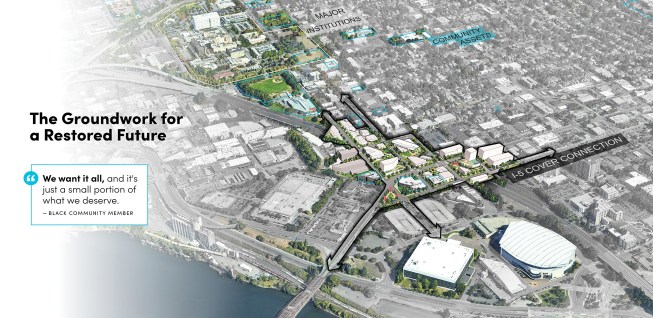
courtesy ZGF Architects
A better freeway cover is an excellent design outcome, but it doesn’t solve the fundamental problem of repairing the moral harm done to a Black community; architects working with a city government to increase new development and investment doesn’t address keeping people in their homes. Those are problems that require far less from architects, wherein they must “cast off the architect’s ego,” as Lewis says. “Doing that as architects and urban designers, we are finding our value outside of the box that people tend to assume we live in,” he adds.
Out of the Box
Partnering with civic organizations is crucial to stepping outside of that box. While they also don’t have one-size-fits-all kits for community re-centering, these organizations can leverage their relationships with residents and act as mediators between designers, neighborhood groups, and government officials. Civic organizations—often nonprofits that employ design, administrative, and development professionals—are, in many ways, a hinge for communication, connections, and strategies.
Design Trust Chicago was founded on this understanding, bringing together neighborhood groups and government agencies to address critical issues surrounding public and shared space in disinvested neighborhoods. Though founders Katherine Darnstadt, AIA, Paola Aguirre, and Elle Ramel had all worked on this issue through their firms, they were frustrated with the problem of scale. The Citizen Architect, Darnstadt says, can work through their firm or as an individual volunteer, but the scale of neighborhood issues in Chicago is too large for a firm or individual.
“In order to resolve that glaring issue that we see time and time again, in Chicago and other cities, you have to build capacity outside the firm, and you have to build it at a systemic and city scale,” she says.
While they also don’t have one-size-fits-all kits for community re-centering, civic organizations can leverage their relationships with residents and act as mediators between designers, neighborhood groups, and government officials.
Darnstadt and her team began by collaborating with local restaurants and business corridors to develop pandemic-responsive outdoor dining and seating spaces. “We started working closely with our planning department to support, from a design and technical assistance side, community-design projects such as pop-up spaces to get people outdoors,” Darnstadt says. “[The city] was handing out money and asking community organizations to create these spaces, but not giving them some of the technical assistance or support that would make the space successful. It wasn’t setting those communities up for long-term success.”
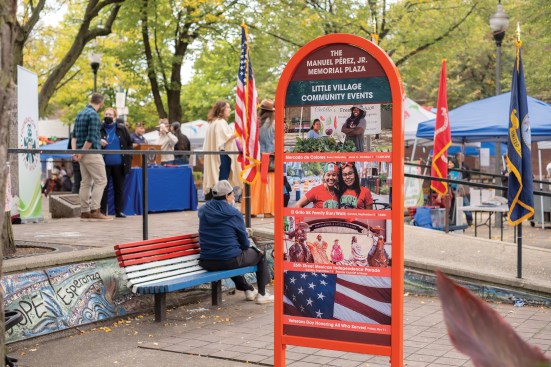
Sarah Joyce
Design Trust Chicago collaborated with the Little Village Community Foundation to reimagine Manuel Perez Jr. Memorial Plaza.
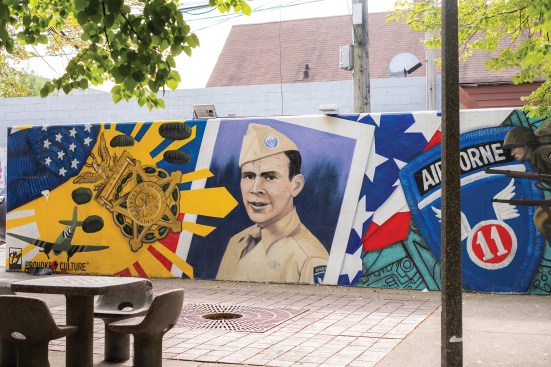
Sarah Joyce
The DTC Manuel Perez Jr. Memoral Plaza project included “new signage, a refreshed mural, and enhanced seating on the only public plaza in a predominately Latino neighborhood,” according to Darnstadt.
DTC has since helped four marginalized neighborhoods create permanent or seasonal outdoor public spaces and has continued that work through its Design Services program, which asks neighborhood groups and businesses to send in their ideas for potential projects. DTC assists those groups in planning, securing funding, and soliciting feedback and ideas from residents. They’re focused on building relationships and processes that secure the longevity of community projects, says Emma Jasinski, community designer at DTC. The city can provide finances for project execution, but without a longer-term plan in place, those projects could rapidly fail, generating more distrust between residents and elected officials.
Philip Barash founded Public Sphere Projects, an organization with offices in Boston, St. Louis, and Santa Fe, N.M., that strategizes around belonging, community, and economic development through public space interventions. Though his work still allows him to flex his designer muscles, he’s become more dedicated to creating meaningful partnerships between residents and municipalities. Recently, he has been working with the Downtown Boston Business Improvement District to help reinvigorate the 30% vacancy rate in one of its commercial corridors that he says, has “wreaked all kinds of havoc on the public realm,” including pedestrian and public space experience.
“A previous generation tenanting effort would have involved something like recruiting Starbucks to come in for the highest per-square-foot rate,” he says. “Instead, we’re working on a strategy that recruits tenants and incentivizes them to use federal money to offset their expenses. We’re focusing on businesses that are primarily BIPOC-owned and emerging.” This effort, he continues, ensures that the business life of the downtown reflects the culture (and cuisine) of Boston’s population. This, he believes, will build trust between the city’s diverse residents if they see the city itself supporting and investing in homegrown businesses.
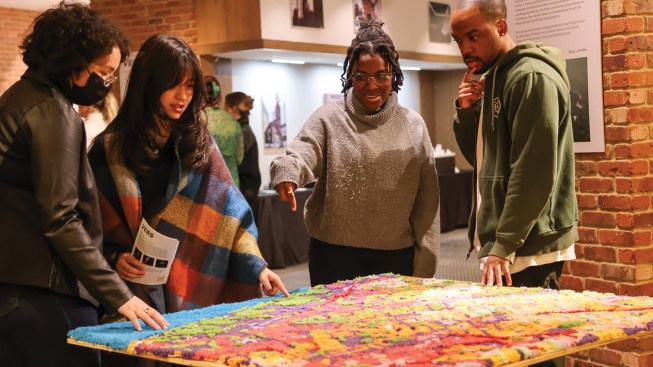
George T. Comeau/Downtown Boston BID
Public Sphere Projects has joined forces with the Downtown Boston Business Improvement District “to build a coalition of entrepreneurs, community leaders, and creatives to imagine vibrant and inclusive ground-floor retail in the district,” PSP founder Philip Barash says.
But small business investment is just one part of many civic groups’—including Public Sphere Projects and Design Trust Chicago—efforts to change fundamental systems that have eroded trust between residents and municipalities.
“We help facilitate movement and coalition building—which leads to trust building—among municipalities, their stakeholders, designers, funders, and others,” Barash says. “I think the best organizations in the field, if they’re really good at their job, are design-agnostic. I mean, the success of my work doesn’t depend on whether a building gets built.”
“Building the capacity of the neighborhood, of the stakeholders, to be at the negotiating table with governments—or with architects, for that matter—is what’s important,” Barash adds.
Handing over the megaphone to communities requires knowledge, humility, and cultural competence—the ability to not barge into a room and believe that design thinking alone will solve critical problems.
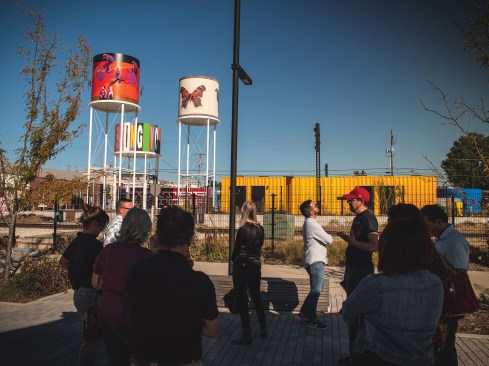
courtesy Creative Arkansas Community Hub and Exchange
In “rapidly growing Northwest Arkansas,” Barash says, PSP is working with the Creative Arkansas Community Hub and Exchange “to convene municipal agencies and cultural leaders on policies that lead to equitable development and peacekeeping across the region.”
What DTC and PSP have done is build an ecosystem that includes architects but centers the community. ZGF also assembled a similar ecosystem, and while the firm’s work will result in a built element, it has catalyzed the nearby residents to create a vision for reparative ownership and land management—which is just as important as the freeway cover itself. I hope, someday soon, a member of the Albina community will run for office on that platform. When communities have that power, they increase their capacity to make structural changes in their own interests—not just getting a new public amenity that benefits their community, but changing the social and political structures that necessitated their fight for a better place.
The Citizen Architect campaign hinges on the notion that communities need design thinking, but sometimes they need someone who can file permits. More likely, they need someone to cut a check, to knock on doors, to screen-print signs, to plant the flowers. But most importantly, they need the bigger megaphone. Handing over the megaphone to communities requires knowledge, humility, and cultural competence—the ability to not barge into a room and believe that design thinking alone will solve critical problems.
“There’s a kind of a hubris in the architectural profession that architects are particularly equipped to solve pressing social problems. So, one way to think of the designer’s role within this construct [is] the designer is equipped, qualified, and maybe in some ways responsible for solving social challenges. It’s not clear to me that that’s really the case,” Barash says.
I agree. The Citizen Architect should be satisfied not when they have obtained enough knowledge of a community to advocate for it by running for political office; rather, when a member of that community feels empowered, resourced, and connected enough to run for office themselves.
